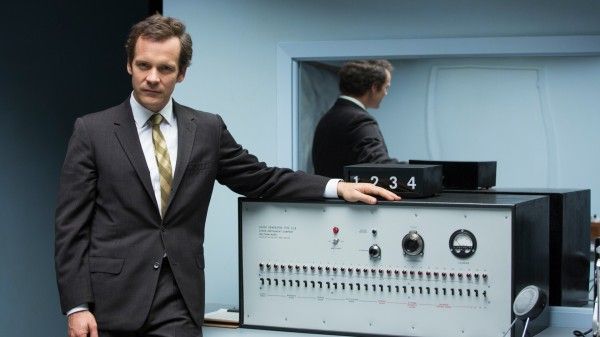Tests on social behavior make us uncomfortable. They can shake our identities. We believe we would act one way, we end up acting differently, and then we’re told our actions are human nature. Rather than looking at what we’ve learned, we get frustrated with our lost sense of self. We weren’t only content being ignorant of what was behind the curtain; we were content being unaware of the curtain. Dr. Stanley Milgram and his experiments challenged our preconceived notions of human relationships. Michael Almereyda’s film on Milgram’s work, Experimenter, tries to follow suit by emphasizing cinematic artifice to challenge our preconceived notions of how a biopic should work. Sadly for Experimenter, not all experiments are successful.
Beginning at Yale University in August 1961, we see Milgram (Peter Sarsgaard) conducting his most famous experiment, which was about obedience. Two people were brought in under the auspices of both being test subjects, but one was secretly working for Milgram. This person would pose as the student, and the true test subject would be the teacher. After asking the student to memorize a list of words, the teacher would administer a quiz, and every wrong answer would be met with an increasing shock. Obviously, the person on Milgram’s team wasn’t being shocked, but a recording would respond with him crying out in pain. The question was, “Would someone follow the authority of the scientist rather than stop hurting the student?” The disturbing answer: No, they would not. They would follow orders.
The Obedience Experiment is taught in Psychology 101 courses today because it’s insightful, fascinating, and unnerving. But that doesn’t translate into a movie if the scientist behind the experiment lacks much of a personality. Stanley Milgram is no Alfred Kinsey. Experimenter is more interested with the work than the man who conducted it, but the man who conducted it is set as the protagonist.
Almereyda has a huge asset in Sarsgaard, who consistently breaks the fourth wall to address the audience. He talks about the experiments, his personal life, and provides various other thoughts and commentary. Sarsgaard plays the role with a mix of cold calculation and surprising sympathy. Milgram needs the answers, but he also pities the people who are about to make an unpleasant revelation about their own behavior. He’s a calm, collected narrator who treats us more like students than confidants. His words are matter-of-fact, but they’re not without emotion.
However, that emotion is not particularly powerful. Milgram is not a tortured figure, and it’s his research that upsets us, not the man. So when left with a flat protagonist who conducted some interesting experiments (although none of his follow-ups were as interesting as the Obedience Experiment), how do you create a compelling story or at least one that tries to follow Milgram’s lead? How do you challenge people to break them out of their pre-conceived notions?
The director conducts an experiment of his own by challenging the artifice of filmmaking. A protagonist breaking the fourth wall is familiar enough that we accept it even though it’s not a common practice. When Sarsgaard addresses us, we’ve already given into the conceit that an actor can turn to the camera and pretend like he’s personally communicating with us. But then Almereyda takes it a step further, and basically conducts his own experiment to see how the audience will respond to the director upending cinematic conventions.
Judging from the screening I attended, not well. I commend Almereyda on trying to figure out how crack the film by not just reporting on what Milgram did, but actually make a movie in the spirit of his subject. What Experimenter attempts does not feel like a gimmick or a desperate ploy. The problem is that because the approach is underdeveloped and clumsily executed, it becomes distracting.
The design of Milgram’s experiments was to hide the true purpose of the experiment and then provide the revelation. Experimenter gets it backwards by pointing to the reveal to highlight the design of the experiment. It would be as if Milgram had told the test subject up front that the switches wouldn’t really administer a shock. The test subject needed to believe in the reality of a different experiment. “It wasn’t deception,” Milgram tells a skeptical student. “It was an illusion.” Experimenter can’t get us to fall for its tricks.
Rating: C-
Click here for all of our Sundance 2015 coverage. Click on the links below for our other reviews:
Matt’s Reviews:
- The Bronze
- The End of the Tour
- Going Clear
- In Football We Trust
- The Mask You Live In
- Mississippi Grind
- Most Likely to Succeed
- Slow West
- Stockholm, Pennsylvania
- True Story
- White God
- Z for Zachariah
Adam’s Reviews


